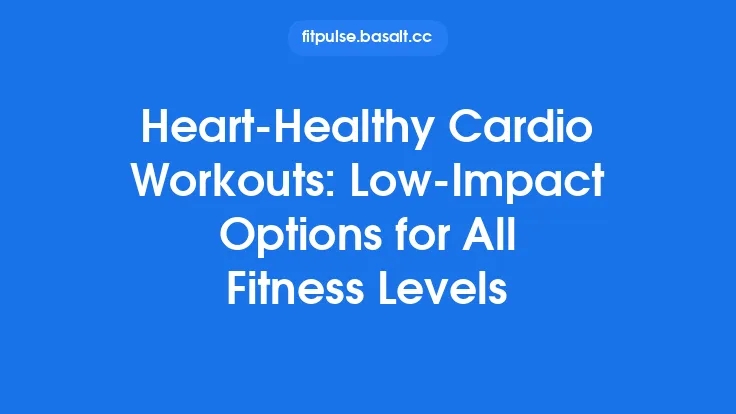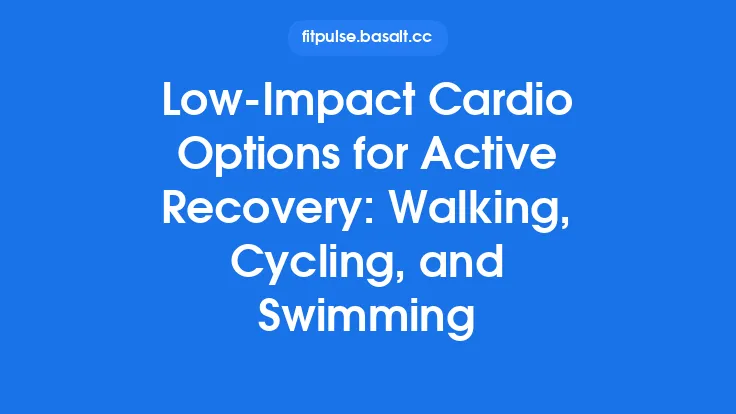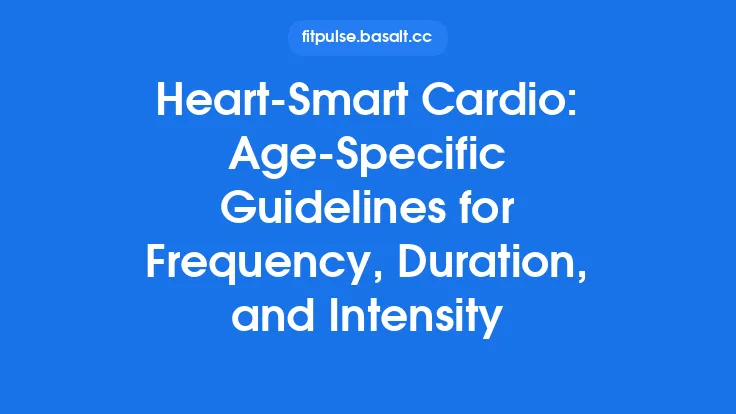A healthy heart and fluid mobility are two of the most valuable assets we can nurture as we move through our senior years. While the desire to stay active never wanes, the way we approach cardiovascular exercise must evolve to respect the natural changes that accompany aging. Low‑impact cardio offers a sweet spot: it elevates heart rate, supports vascular health, and improves functional movement without placing excessive stress on joints, bones, or the nervous system. Below is a comprehensive guide that walks you through the science, the options, and the practical steps needed to build a sustainable, heart‑friendly cardio routine that also enhances everyday mobility.
Understanding Cardiovascular Changes in Later Life
Aging brings a series of physiological shifts that directly affect how the heart and circulatory system respond to exercise:
| Change | What It Means for Cardio |
|---|---|
| Reduced Maximal Heart Rate | The ceiling for heart‑rate‑based intensity drops (approximately 220 – age). This makes it essential to gauge effort by perceived exertion rather than chasing high numbers. |
| Decreased Stroke Volume | The amount of blood pumped per beat declines, so the heart compensates by beating slightly faster at any given workload. |
| Increased Arterial Stiffness | Blood vessels lose some elasticity, raising systolic pressure during activity. Low‑impact work helps keep pressures within safe ranges. |
| Altered Autonomic Balance | The sympathetic (fight‑or‑flight) and parasympathetic (rest‑and‑digest) systems become less responsive, affecting recovery speed. |
| Mitochondrial Efficiency Decline | Cells become less efficient at producing energy, which can lead to quicker fatigue. Consistent, moderate cardio can blunt this decline. |
Understanding these shifts helps you select activities that respect the heart’s capacity while still delivering the cardiovascular stimulus needed for health benefits.
Why Low‑Impact Cardio Is Ideal for Seniors
Low‑impact cardio is defined by movements that keep at least one foot—or a large portion of the body—in contact with a stable surface, minimizing the ground‑reaction forces transmitted through joints. The advantages for seniors include:
- Joint Preservation – Reduced impact lessens wear on cartilage, a crucial factor for those with osteoarthritis or early joint degeneration.
- Balance Support – Many low‑impact modalities incorporate rhythmic, bilateral patterns that reinforce proprioception and steadiness.
- Scalable Intensity – Effort can be increased by adjusting speed, resistance, or range of motion without needing to add high‑impact stress.
- Accessibility – Most low‑impact activities can be performed indoors, outdoors, or even seated, making them adaptable to varying mobility levels.
- Cardiovascular Efficacy – Research shows that moderate‑intensity, low‑impact exercise improves VO₂max, lowers resting blood pressure, and enhances endothelial function—key markers of heart health.
Core Low‑Impact Modalities
Below is a curated list of low‑impact cardio options, each with a brief description of the physiological demands and practical considerations.
| Modality | Primary Cardiovascular Load | Mobility/Balance Benefits | Typical Equipment |
|---|---|---|---|
| Brisk Walking | Sustained moderate heart rate; easy to gauge effort via conversation | Improves gait mechanics, hip extension, ankle stability | Comfortable shoes; optional walking poles |
| Stationary Cycling (Recumbent or Upright) | Lower body work with controlled resistance; heart rate rises steadily | Enhances knee flexion/extension, hip mobility; seated position reduces fall risk | Bike with adjustable seat and resistance |
| Elliptical Trainer | Full‑body, low‑impact motion; can target both upper and lower limbs | Promotes coordinated arm‑leg patterns, improves shoulder range | Elliptical with moving handles |
| Water Aerobics / Aqua Jogging | Hydrostatic pressure adds resistance while buoyancy reduces joint load | Increases hip and shoulder mobility; water turbulence challenges balance | Pool with shallow and deep zones |
| Seated Marching / Chair Aerobics | Upper‑body and core engagement; heart rate rises through rhythmic movement | Maintains hip flexion, ankle dorsiflexion; safe for limited standing ability | Sturdy chair, optional light dumbbells |
| Tai Chi‑Inspired Cardio Flow | Slow‑to‑moderate pace with continuous movement; heart rate modestly elevated | Enhances postural control, spinal rotation, and lower‑limb coordination | Open space, optional mat |
| Low‑Impact Step‑Up Sequences | Alternating leg work on a low platform; heart rate climbs with step height | Improves knee stability, ankle dorsiflexion, and functional stepping ability | Step platform (4–6 inches) |
| Dance‑Based Cardio (e.g., Ballroom, Zumba Gold) | Rhythmic, continuous movement; heart rate can be modulated by tempo | Boosts hip rotation, shoulder mobility, and social engagement | Music system, open floor space |
When selecting a modality, consider personal preferences, existing joint conditions, and the environment in which you’ll train. Variety not only prevents boredom but also ensures a more comprehensive stimulus for the cardiovascular and musculoskeletal systems.
Designing a Sustainable Senior Cardio Routine
A well‑structured routine balances frequency, duration, and progression while respecting the body’s recovery needs. Below is a flexible template that can be customized:
- Frequency – Aim for 3–5 sessions per week. Consistency trumps intensity for long‑term heart health.
- Duration – Start with 15–20 minutes per session, gradually extending to 30–45 minutes as endurance improves.
- Intensity – Use the Rate of Perceived Exertion (RPE) scale (0–10). Target an RPE of 3–5 (light to moderate) for most sessions. On “challenge days,” you may push to 6–7 (somewhat hard) for short intervals.
- Progression Framework – Follow the “10% rule”: increase total weekly volume (time or distance) by no more than 10 % each week. This minimizes overuse risk while fostering adaptation.
- Warm‑Up & Cool‑Down – Even though detailed warm‑up protocols belong to a separate article, a brief 5‑minute low‑intensity activity (e.g., slow marching, gentle arm circles) is essential to prime the cardiovascular system and prepare joints for movement. End each session with a 5‑minute gradual slowdown and gentle stretching of major muscle groups.
- Periodization – Incorporate “micro‑cycles” of 4–6 weeks where you alternate between “steady‑state” weeks (continuous moderate cardio) and “interval” weeks (short bursts of higher effort followed by recovery). This variation maintains cardiovascular stimulus without monotony.
Integrating Mobility and Balance Work
Low‑impact cardio alone does not fully address the functional challenges seniors often face. Pairing cardio with targeted mobility and balance drills creates a synergistic effect:
- Dynamic Hip Openers – Perform leg swings (forward/backward and side‑to‑side) during the cool‑down to maintain hip range.
- Ankle Alphabet – While seated, trace the alphabet with the big toe to preserve ankle dorsiflexion and proprioception.
- Single‑Leg Stance with Light Resistance – Hold onto a sturdy surface, lift one foot, and perform gentle arm curls. Switch sides after 30 seconds.
- Core Activation – Incorporate seated or standing pelvic tilts and diaphragmatic breathing to improve trunk stability, which supports upright cardio activities.
- Visual‑Motor Coordination – Simple ball‑catch drills or following a moving light can sharpen reaction time, complementing the rhythmic nature of cardio.
These adjuncts can be woven into the warm‑up, cool‑down, or even interspersed as brief “active recovery” intervals during longer cardio sessions.
Leveraging Technology and Community Resources
Modern tools can make low‑impact cardio more engaging and safer:
- Wearable Heart‑Rate Monitors – Even basic optical sensors provide real‑time feedback, helping you stay within the desired RPE zone.
- Virtual Classes – Many senior centers and fitness platforms now stream low‑impact cardio sessions tailored for older adults, offering guidance without the need for travel.
- Pedal‑Assist Devices – E‑bikes and motorized recumbent bikes allow seniors to cover longer distances with reduced strain, encouraging outdoor activity.
- Community Walking Groups – Social interaction boosts adherence and provides a built‑in safety net for outdoor cardio.
- Accessible Apps – Programs that let you log duration, perceived effort, and any symptoms (e.g., shortness of breath) create a simple health record you can share with your healthcare provider.
When adopting technology, prioritize ease of use and reliability. A device that feels cumbersome will quickly be abandoned.
Nutrition and Recovery for Senior Cardio
Fueling the body appropriately enhances cardiovascular performance and supports mobility:
- Balanced Macronutrients – Aim for a diet rich in lean proteins (to preserve muscle mass), complex carbohydrates (for sustained energy), and healthy fats (for vascular health). A typical distribution might be 20–25 % protein, 45–55 % carbs, and 25–30 % fats.
- Hydration – Even mild dehydration can elevate heart rate and impair balance. Sip water before, during, and after sessions; consider electrolyte‑enhanced drinks for longer workouts.
- Timing – A light snack containing carbohydrates and protein (e.g., a banana with a tablespoon of nut butter) 30–60 minutes before cardio can improve stamina without causing gastrointestinal discomfort.
- Post‑Exercise Recovery – Within two hours of finishing, consume a protein‑rich snack (Greek yogurt, cottage cheese, or a protein shake) to aid muscle repair and replenish glycogen stores.
- Anti‑Inflammatory Foods – Incorporate omega‑3‑rich fish, berries, leafy greens, and nuts to mitigate low‑grade inflammation that can affect both heart and joint health.
Adequate sleep (7–9 hours) and stress‑management practices (e.g., gentle yoga, meditation) further complement cardio benefits by supporting autonomic balance and hormonal regulation.
Monitoring Health Markers Without Over‑Technical Metrics
While detailed cardiovascular testing belongs to clinical settings, seniors can keep an eye on a few practical indicators that reflect how well their cardio routine is serving them:
- Resting Heart Rate (RHR) – A gradual decline over weeks often signals improved cardiovascular efficiency. Measure first thing in the morning after a calm wake‑up.
- Recovery Heart Rate – After a 5‑minute moderate walk, note how quickly the heart rate returns to baseline. A drop of 20–30 bpm within a minute is a positive sign.
- Breathlessness Scale – Use a simple 0–10 scale (0 = no shortness of breath, 10 = maximal breathlessness) during activity. Consistently low scores at the same workload indicate progress.
- Functional Tests – The “Timed Up‑and‑Go” (stand, walk 3 m, turn, sit) and the “6‑Minute Walk Test” provide tangible data on mobility and endurance.
- Blood Pressure Checks – Regular home monitoring (morning and evening) helps ensure that cardio is contributing to stable or improving readings.
Documenting these markers in a notebook or digital log can reveal trends and guide adjustments without the need for complex lab work.
Adapting to Common Age‑Related Challenges
Even with a well‑designed program, seniors may encounter obstacles. Below are strategies to keep cardio sustainable:
| Challenge | Adaptive Strategy |
|---|---|
| Joint Pain or Osteoarthritis | Choose water‑based or seated modalities; reduce resistance; incorporate joint‑friendly ranges of motion. |
| Reduced Vision | Exercise in well‑lit areas; use high‑contrast equipment; consider auditory cues (music beats) to guide pace. |
| Medication‑Induced Fatigue | Schedule cardio sessions during peak energy windows; keep intensity moderate; discuss timing with a physician. |
| Balance Instability | Use a sturdy chair or rail for support; start with bilateral movements before progressing to single‑leg work. |
| Limited Access to Facilities | Invest in a low‑cost recumbent bike or resistance bands; use online video classes that require minimal space. |
| Social Isolation | Join local senior fitness clubs, community centers, or virtual groups; pair cardio with a walking buddy. |
Flexibility in approach ensures that setbacks become temporary detours rather than permanent roadblocks.
Creating a Lifelong Cardio Habit
The ultimate goal is to embed low‑impact cardio into the fabric of daily life, making it as routine as brushing teeth. Here are actionable steps to cement the habit:
- Anchor to Existing Routines – Pair cardio with a daily habit (e.g., a 20‑minute walk after lunch). The existing cue triggers the new behavior.
- Set Micro‑Goals – Instead of vague “exercise more,” aim for “walk 1,000 steps after dinner on Tuesdays and Thursdays.”
- Celebrate Milestones – Mark each week of consistency with a small reward (new music playlist, a favorite healthy snack).
- Track Progress Visually – Use a wall calendar, habit‑tracking app, or simple checklist to see streaks grow.
- Plan for Variability – Keep a “rain‑day” list of indoor activities (chair aerobics, indoor cycling) to avoid missed sessions due to weather.
- Engage the Support System – Share your cardio plan with family or friends; invite them to join or simply check in on your progress.
- Re‑evaluate Quarterly – Review your health markers, enjoyment level, and any emerging limitations. Adjust modality, duration, or intensity accordingly.
By treating low‑impact cardio as a flexible, enjoyable, and socially connected part of life, seniors can protect their hearts, preserve mobility, and enjoy a higher quality of life well into the golden years.





